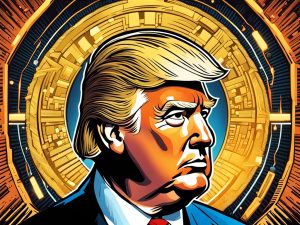The Future of Stablecoins: A Treasury Showdown Ahead?
Imagine you’re at a coffee shop, sipping on your favorite brew, chatting with a buddy about your investment strategies. You lean in and say, “Hey, did you hear about what the U.S. Treasury thinks about stablecoins?” Suddenly, the conversation shifts from casual chit-chat to a deep dive into how the evolution of digital currency might change everything we know about crypto. So let’s unpack this whole situation together, shall we?
Key Takeaways:
- The U.S. Treasury is worried about the rise of stablecoins and their ties to traditional financial markets.
- A recommendation from the Treasury suggests a shift toward Central Bank Digital Currencies (CBDCs).
- Tether and other stablecoins are buying massive amounts of U.S. Treasuries – $120 billion worth, in fact!
- The Treasury fears instability from potential “fire sales” of T-bills if a major stablecoin collapses.
- There’s a lot of political tension regarding the implementation of CBDCs in the U.S.
Now, let’s dig a little deeper into what’s actually being discussed here. The U.S. Treasury recently released a report that definitely raised some eyebrows. The main concern? The fast-growing stablecoin market. These digital assets are supposed to offer stability (hence the name) by being pegged to traditional currencies like the U.S. dollar. However, the Treasury is throwing up a big red caution flag.
They’ve pointed out that private, unregulated stablecoins could be a risk to the financial system. It’s like when your buddy at the coffee shop insists his new investment strategy is foolproof—until it crashes and burns. The Treasury likens the situation to the so-called “wildcat” currencies of the 1800s, which were replaced by government-backed currencies. Their proposal? State-backed CBDCs could come to the rescue.
The Financial Ecosystem and Stablecoins
Stablecoins have become critical to the crypto ecosystem. They allow people to switch in and out of crypto positions without dealing with fiat currencies directly—super convenient, right? In fact, over 80% of all crypto transactions use stablecoins! Tether’s USDT is the heavyweight champion here, boasting around $53 billion in trading volume in just one day. Think about that—a lot of activity rides on the stability of these digital tokens.
Yet, here lies the catch: while stablecoins may help bolster demand for U.S. Treasuries, the Treasury doesn’t seem to buy that argument. Their report points to the troubling trend of stablecoins de-pegging or collapsing. If a big player like Tether were to fail, the fallout could be catastrophic. They predict a chaotic “fire sale” of T-bills by stablecoin issuers, which might wreak havoc not just on the crypto market, but also on traditional finance.
The Call for CBDCs
What’s the Treasury’s solution? They’re advocating for a transition to a Central Bank Digital Currency. This would be a government-issued digital dollar, providing a more stable and regulated alternative to privately issued stablecoins. But here’s the kicker: this topic is stirring political controversy across the U.S. It has voters polarizing into camps with opinions ranging from vehement supporters to staunch opponents who see CBDCs as a form of government overreach.
In fact, prominent Republicans, even former President Donald Trump, have made waves speaking out against CBDCs, branding them as "Big Brother’s digital dollar." Irony alert! Trump is also involved in launching his own crypto project that plans to issue a stablecoin. Talk about a mixed message!
What This Means for Investors
For you, as a potential investor, this may sound like quite a roller coaster. Here are some practical takeaways:
-
Stay Informed: Keep an eye on upcoming regulations concerning stablecoins and CBDCs. Changes in legislation could impact your investment strategies.
-
Diversify: If you’re heavily invested in stablecoins, consider diversifying into other cryptocurrencies or asset classes. This could mitigate risks if stablecoins stumble.
-
Understand the Risks: Know what you’re putting your money into. A sudden collapse in a major stablecoin could cost you.
-
Consider Volatility: The crypto market can be wildly unpredictable. Even though stablecoins are pegged to stable assets, they aren’t immune to market fluctuations.
- Assess Your Stance on CBDCs: Educate yourself on the pros and cons of CBDCs, especially if regulatory changes come into play that could affect how you use crypto.
All this brings us to a deeper reflection. If we can’t fully trust the stability of stablecoins, what does that mean for the future of the crypto market as a whole? Are we on the cusp of a major overhaul in how we view and use digital currencies, or is this just a temporary bump in the road?
It’s a really interesting time to be involved in crypto, and I’m all ears to hear what you think!





 By
By
 By
By
 By
By


 By
By